Pilgrimage to India Day 1, Sarnath
Hello! Today is the day we begin our pilgrimage retracing the footsteps of the Buddha, starting from Sarnath, where the Buddha gave his first sermon.
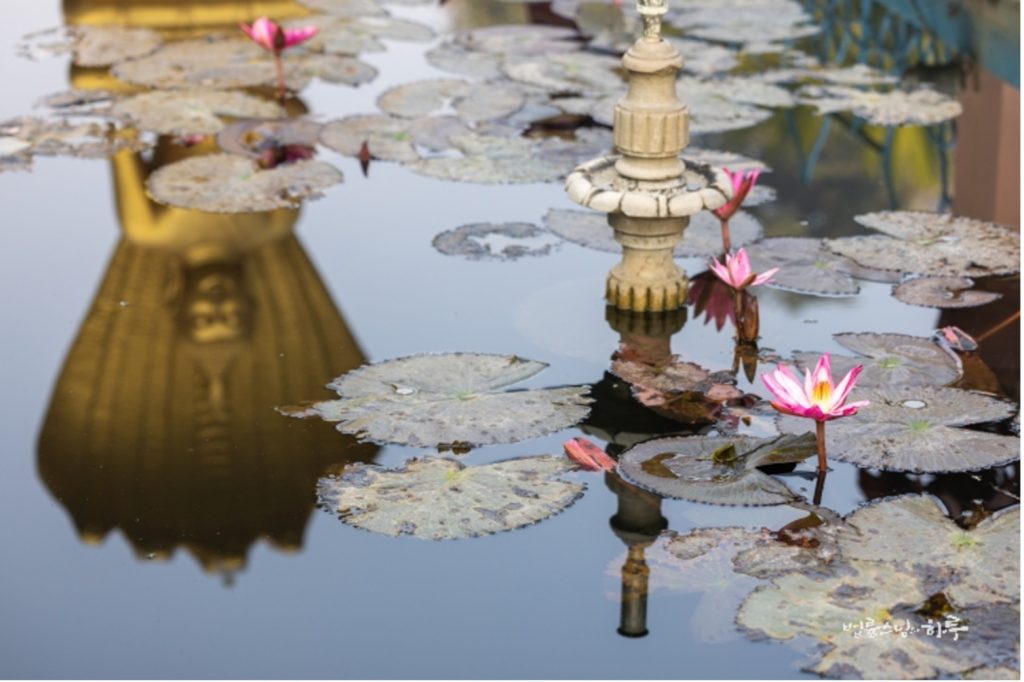
After finishing morning practice and meditation, Ven. Pomnyun Sunim loaded the boxes for Sujata Academy onto the bus. The buses for other pilgrims had no spare space, so all the boxes containing communal items were loaded onto the bus in which Sunim was riding.
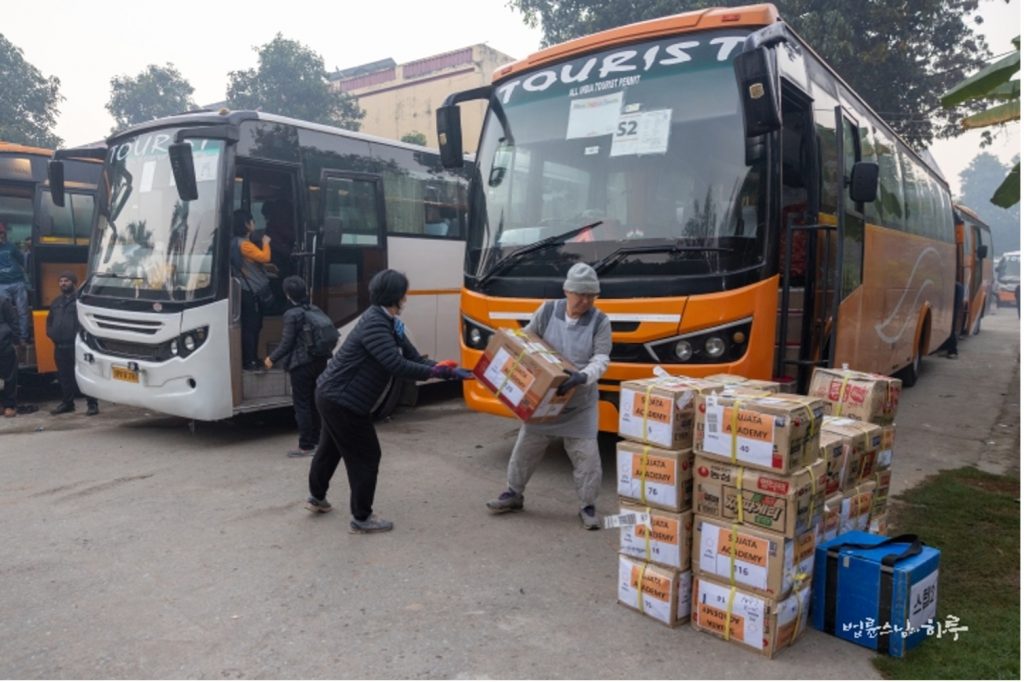
In order to depart for Sujata Academy immediately after the precepts ceremony, the Team A pilgrims loaded their luggage onto their buses before heading to Sarnath.
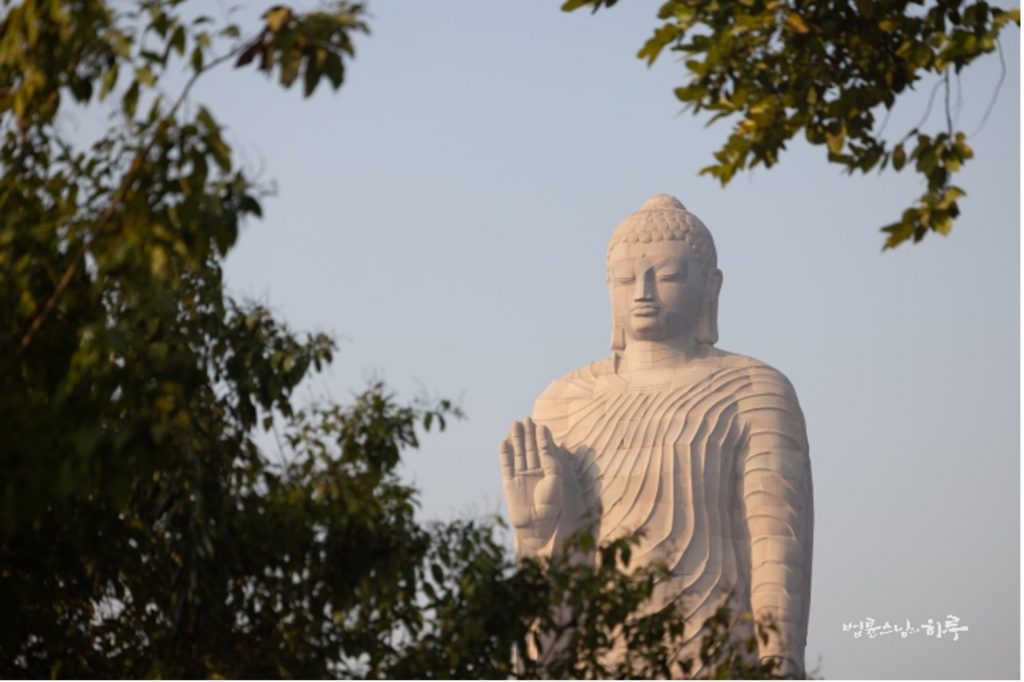
For this pilgrimage, 1,250 pilgrims were divided into Team A and Team B. It was planned that Team A would leave for each pilgrimage site half a day earlier than Team B. And when Team B arrives at each of the 10 pilgrimage sites, all 1,250 pilgrims would have a Dharma meeting with Ven. Pomnyun Sunim.
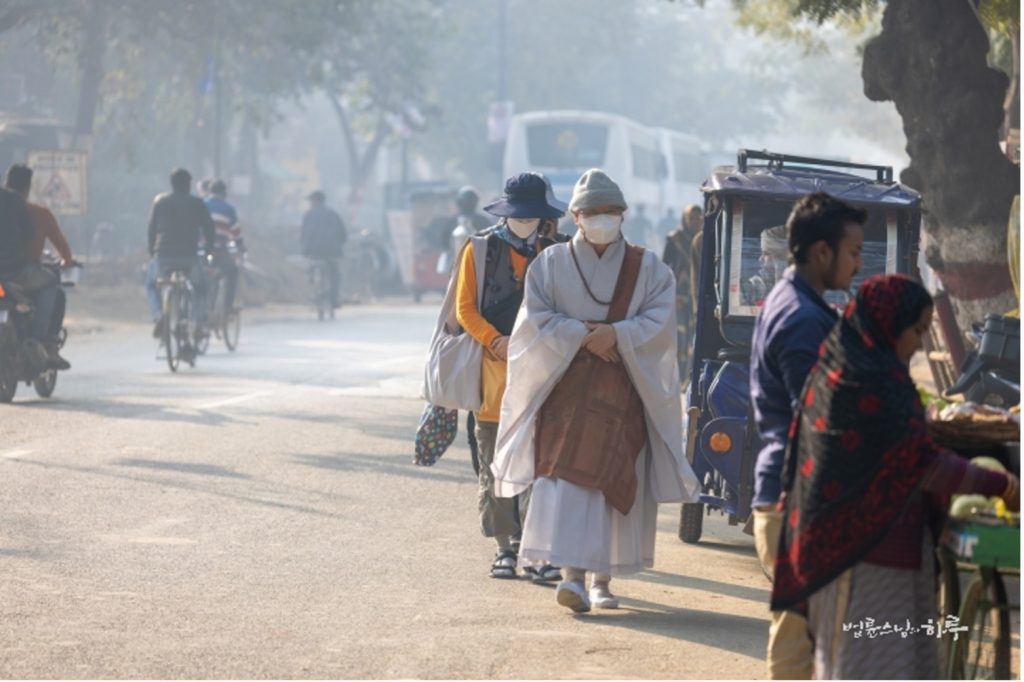
Sunim walked to Sarnath from the Thai temple where he stayed overnight. On arriving, Sunim walked around Sarnath to decide the route for the pilgrims to take before they arrived.
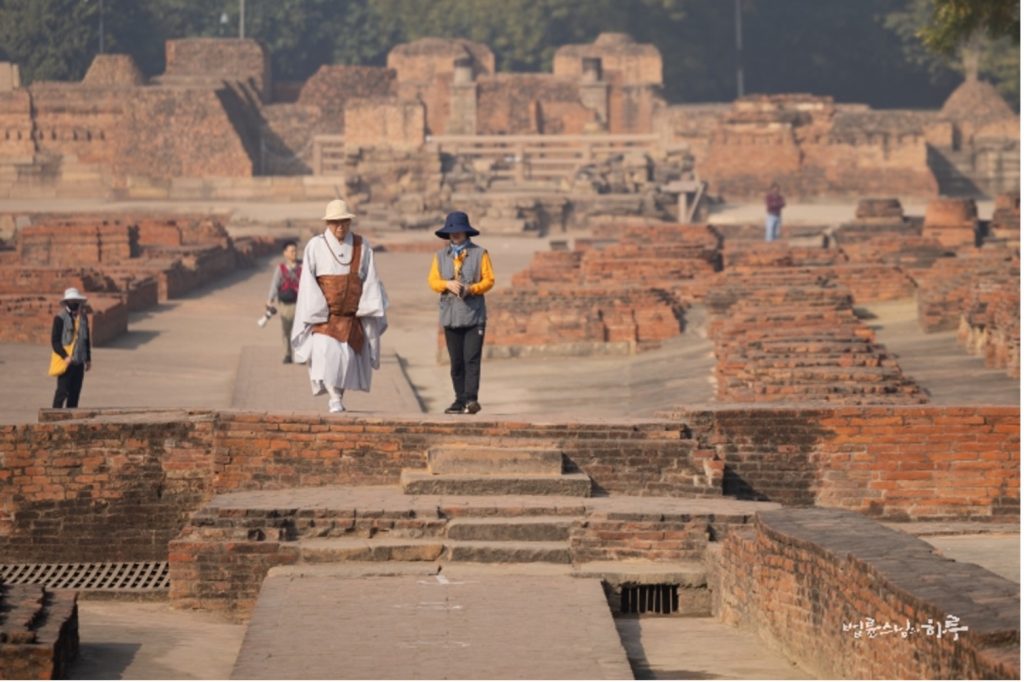
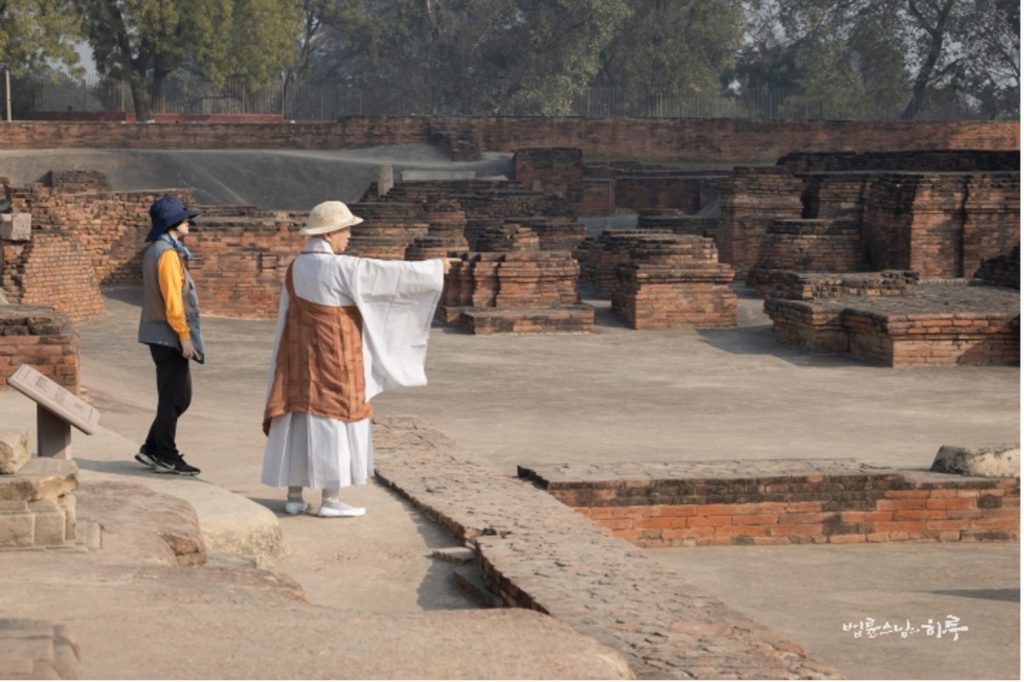
Pilgrims who had visited the river Ganga (Ganges), the museum, and the modern Mulangandhakuti Vihara earlier began to arrive at 9:30 am.
“Is everybody here?”
“Yes, everybody is here.”
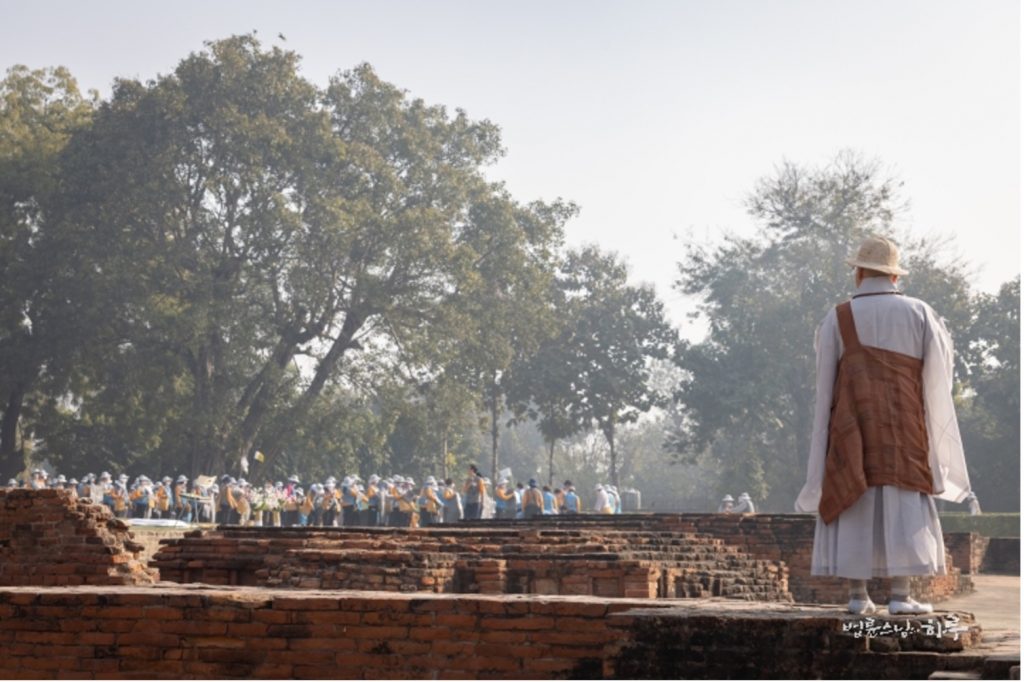
It took a while for everyone to find a place to sit because there were 1,250 pilgrims. After checking that their transceivers were working properly, the Dharma meeting began at 10:30 am.
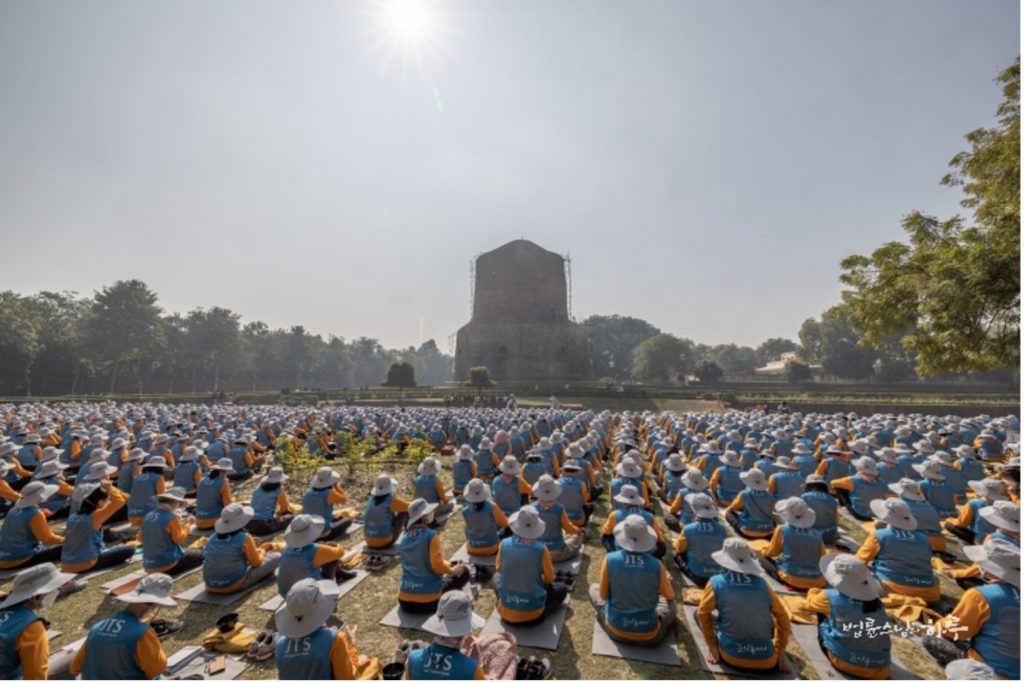
Sunim first explained why Sarnath is a sacred Buddhist pilgrimage site.
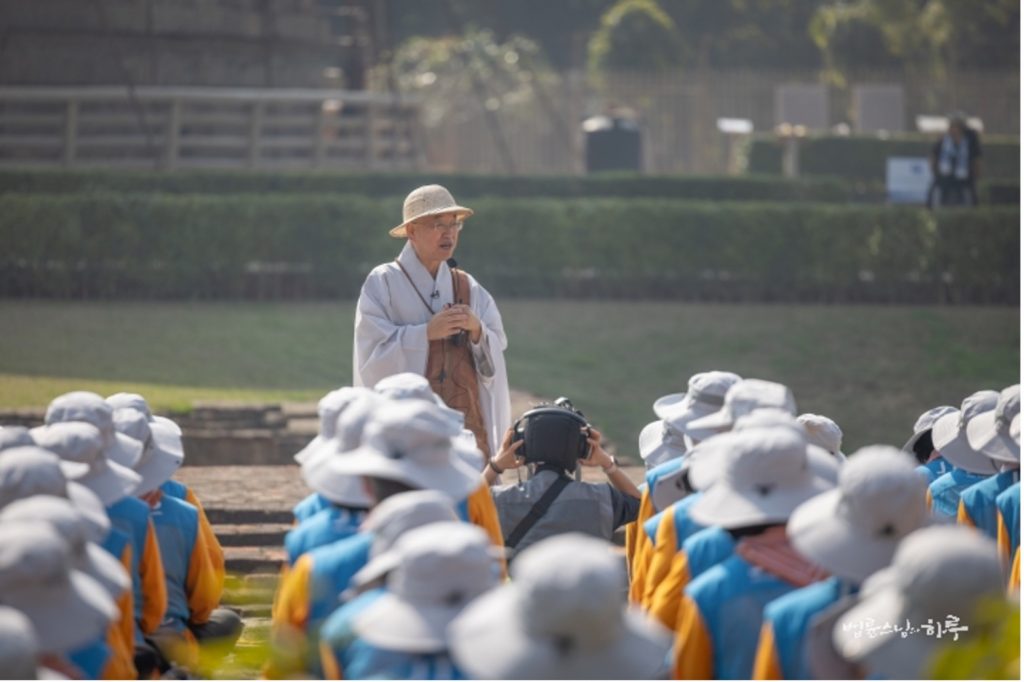
“This is Sarnath, where the Buddha gave his first sermon. Sarnath was part of the city of Varanasi and the kingdom of Varanasi during the Buddha’s lifetime. It was called Kashi at the time. It has a history of 3,000 years and is now called Varanasi. Many cities of the Buddha’s lifetime were destroyed or have disappeared, but Varanasi still thrives and is also considered the most important Hindu pilgrimage site.
“Bodies of middle and upper caste people were cremated on the shore of the Ganga, but those of the lower castes and untouchables were discarded in the forests. This custom is similar to the traditional Korean burial custom of the old days when graves were not made for people of the lower classes. This place, about six kilometers north of Varanasi, was a forest where corpses were left. Forests for corpses were considered polluted and couldn’t be located near cities. People rarely visited these places and thus ascetics found that they could practice there in silence. A forest used for corpse disposal was called Sitavana.
The most tainted place became the most sacred place “This place was Sitavana for the residents of Varanasi and the Buddha came to this place to give his first sermon. It was considered the most tainted place where corpses were discarded, and now it is considered the most sacred place because the Buddha gave his first sermon here.
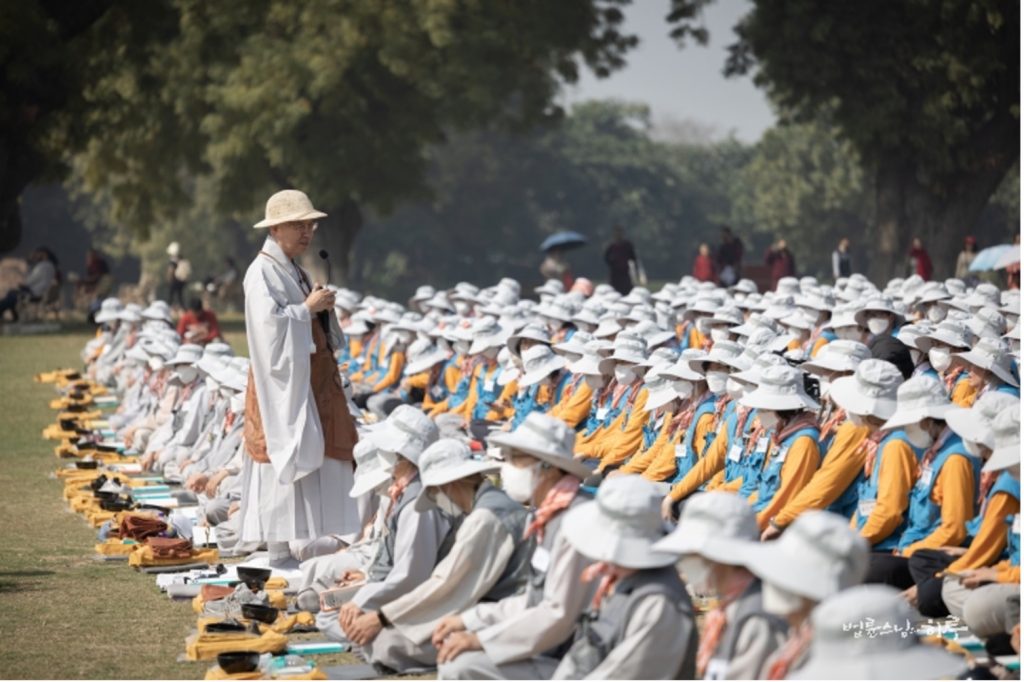
“Upon entering Sarnath, you can see a large circle on the ground to your left. This is the site where the Buddha set the Wheel of Dharma in motion. It is called Dharmarajika Stupa. Dharma means the law or the right way of living and Rajika means wheel. So Dharmarajika means the Wheel of Dharma.
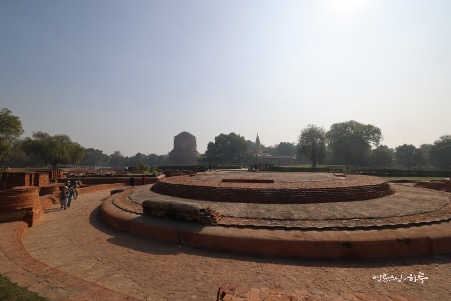
“A stupa was built to memorialize the Buddha’s first sermon here, but a Hindu king toppled the stupa and used the bricks to build his palace. It is said that a container was excavated from the stupa but that its contents were scattered in the river. Probably it contained the remains of the Buddha. That stupa no longer exists but this place is still remembered as the site of the Buddha’s first sermon.
“After attaining enlightenment, the Buddha thought about who would best understand the Dharma and his thoughts turned to his five companion ascetics who had practiced with him before. They were practicing in Sarnath. After listening to the Buddha’s first sermon, Kaundinya attained enlightenment first among the five ascetics. The Buddha continued his teaching for a week for the other four. Two more ascetics attained enlightenment three days after Kaundinya, and then the last two ascetics attained enlightenment three days after that. Hence all five were enlightened in a week.
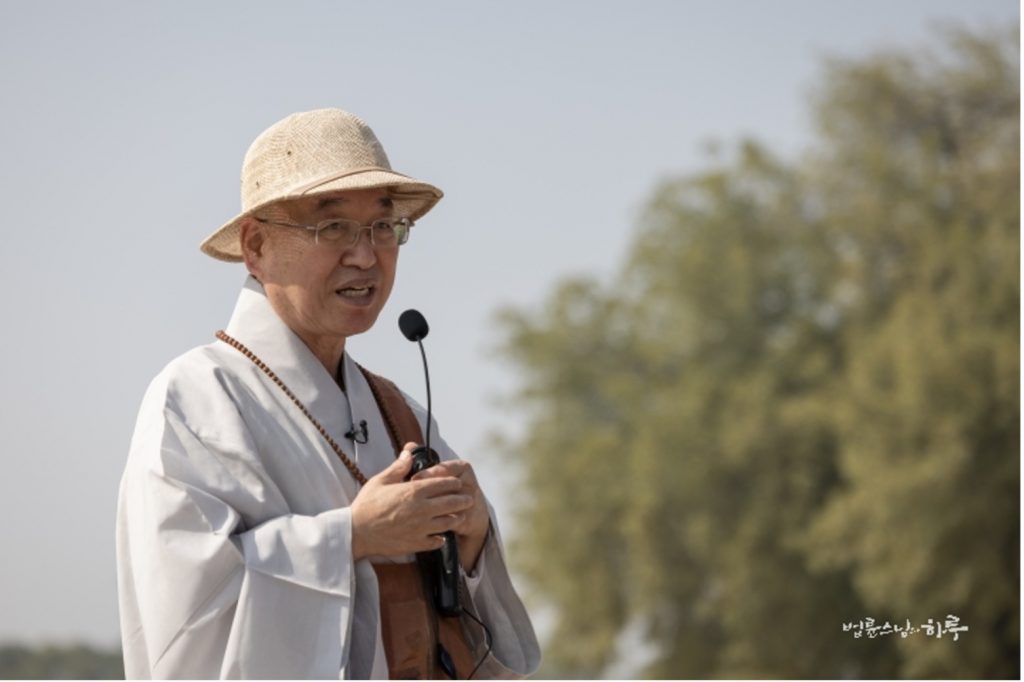
The place where the Three Jewels of the Buddha, the Dharma, and the Sangha were first established
“Bodh Gaya is the place where the Buddha, the one who attained enlightenment on his own, appeared. And Sarnath is the place where the first enlightened person, who was enlightened after listening to the Buddha’s teaching, appeared. These days, ‘sangha’ means a community of ordained monks, but its original meaning was a community of people who were enlightened after listening to the Dharma. The person who was enlightened on his own is the Buddha. The Buddha’s teaching to awaken unenlightened beings is the Dharma. And a community of people who are enlightened after listening to the Dharma is the Sangha. Sangha is a plural noun denoting more than one enlightened person. Thus, the Three Jewels of the Buddha, the Dharma, and the Sangha were established here.
“The stupa you see behind me is Dhamekh Stupa. After Kaundinya attained enlightenment, the Buddha continued his sermons for the four ascetics, and this is the place where the second sermon was given.
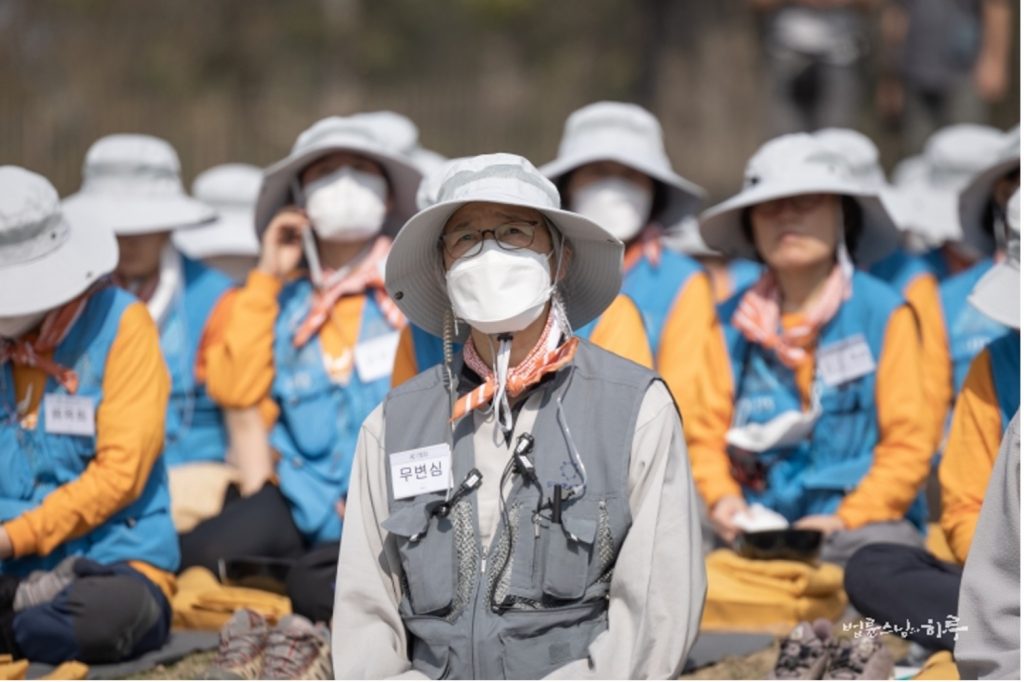
“After the Buddha set the Wheel of Dharma in motion here, many ascetics came here to practice. At first, there was no monastery but later Deer Park Monastery was built. In Hindi, it is called Mulagandhakuti Vihara. Because of the Ashoka pillar at Mulagandhakuti, it was possible to identify this place as the site of the Buddha’s first sermon. Four lions are carved on the capital of the pillar, which was adopted as the national emblem of India; the national emblem of India originated in Sarnath.”
Next, the pilgrims recited the part of the sutra that describes the Buddha’s first sermon at Sarnath.
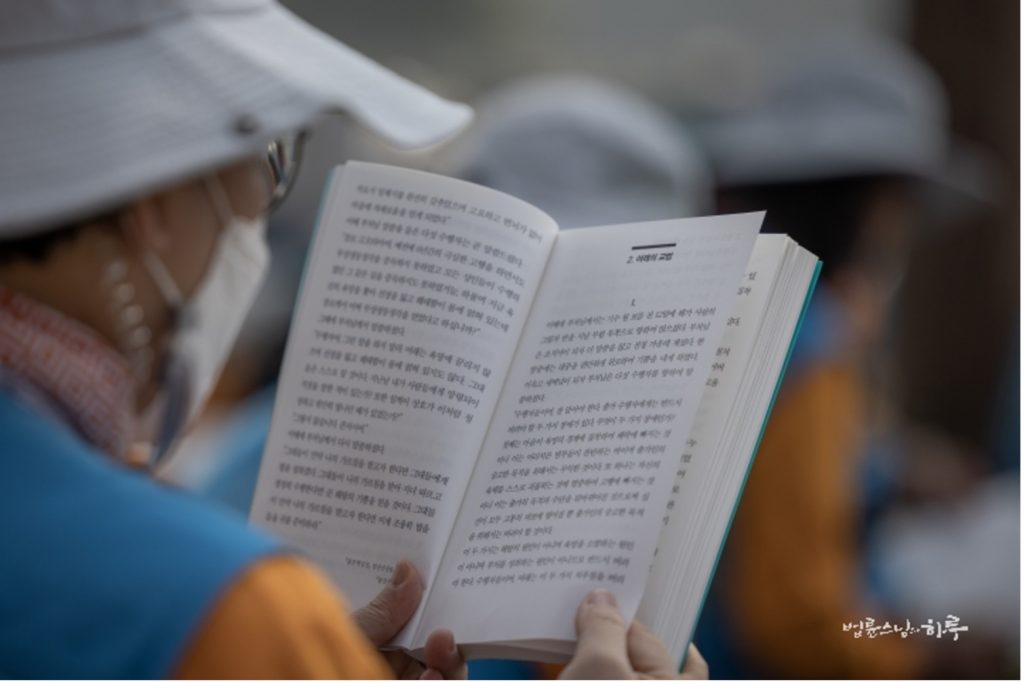
After reciting the sutra, the pilgrims meditated while imagining the scene of the Buddha giving his first sermon to the five ascetics. We felt as though we could feel the Buddha’s breath at the tip of our nose.
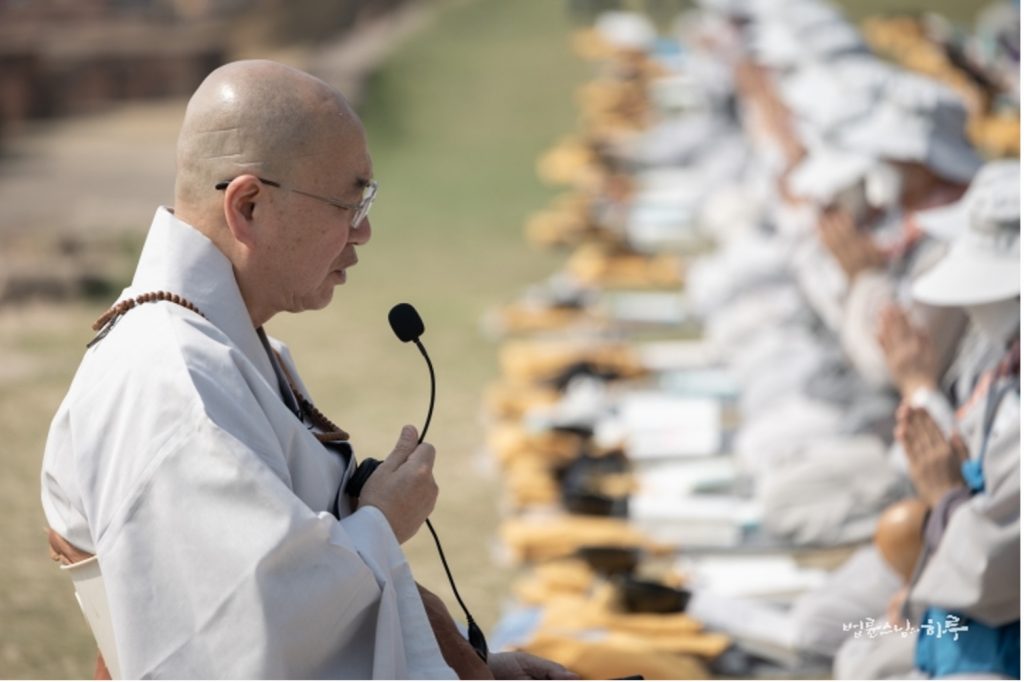
When we opened our eyes, Dhamekh Stupa was clearly visible before us.

Next, the precepts ceremony was held at the place of the Buddha’s first sermon.

“For the precepts ceremony, have the mindset that you will practice diligently as a lay practitioner, such as Yasa’s father Kuriga if you are a man and like Yasa’s wife and mother if you are a woman. Live as a practitioner from the moment you receive a robe and a bowl today until you return them in Sankissa.”
The 1,250 pilgrims received moxibustion as a symbol of repentance for past wrongs and as a vow to observe the precepts.
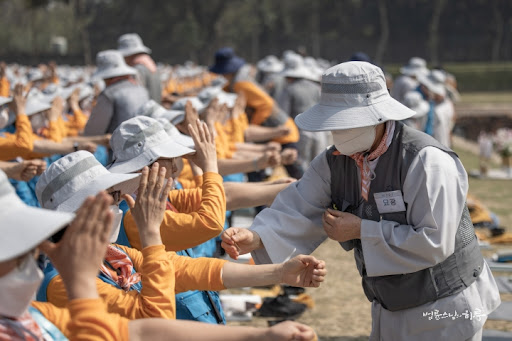
Sunim explained the reason for giving the robe and bowl.
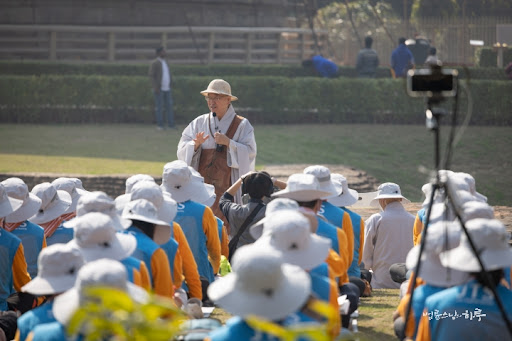
“You are not tourists but pilgrims, so from this moment on, you should have the mindset of a practitioner. Receiving the bowl symbolizes your vow not to be bothered by the food you eat. Have the mindset that you will beg for alms food. Receiving the robe symbolizes your vow not to be bothered by where you sleep. Have the mindset that you will wear a robe made of rags and sleep under a tree. In Zen Buddhism, the bowl and robe were used as symbols of Dharma transmission. By receiving the bowl and robe, you are making a vow to live frugally and humbly.”
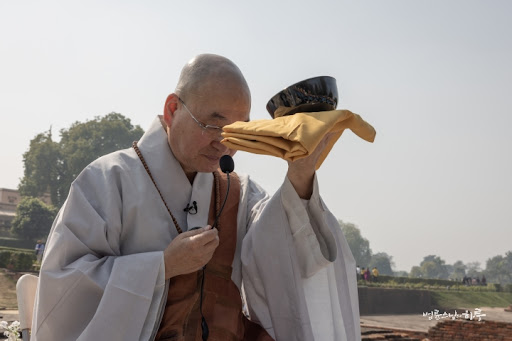
Sunim made a gesture of giving a robe and a bowl to each of the 1,250 pilgrims.
“I give you a robe and a bowl.”
“Thank you.”
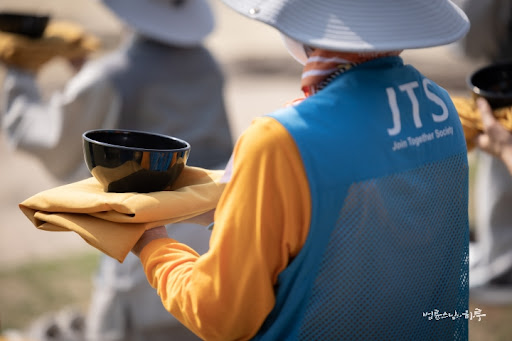

Thus, 1,250 new practitioners were born. Everyone put on their robe and participated in the Yebul ceremony.
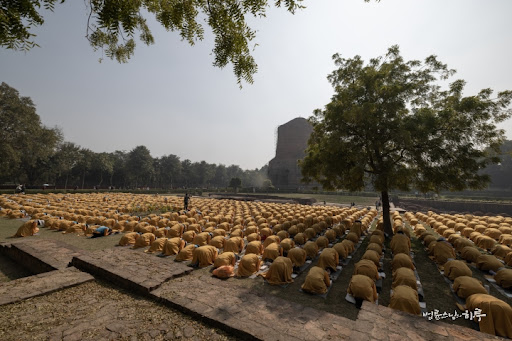
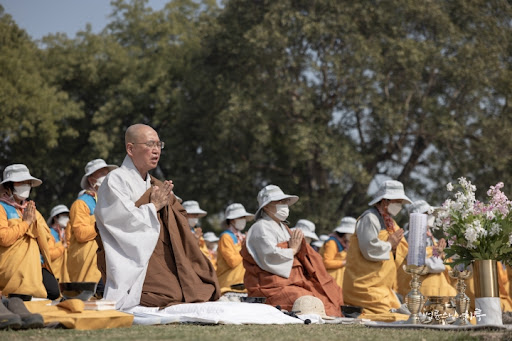
Afterward, Sunim gave a talk on the significance of beginning our pilgrimage in India from Sarnath.
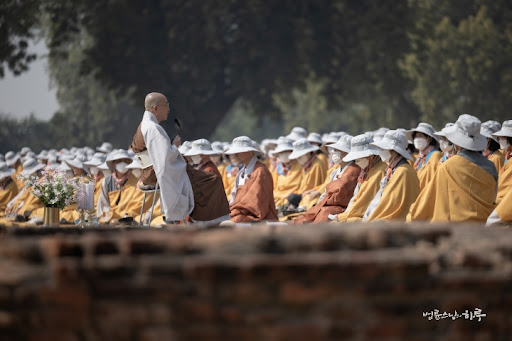
“When did the Buddha become a Buddha? Some say that he was born a Buddha, but to be precise, he wasn’t yet a buddha when he was born. ‘Buddha’ means one who is enlightened on his own, so one has to first be enlightened to be a Buddha. Therefore, the Buddha became a Buddha in Bodh Gaya, where he attained enlightenment.
The place where the Buddha appeared for the first time from the standpoint of an unenlightened being
“Even if there is a Buddha, unenlightened beings won’t know the existence of the Buddha unless they receive teachings. Therefore, from the standpoint of unenlightened beings, Sarnath, where the Buddha gave his first sermon, is where the Buddha first appeared in the world. The one who gave teachings to lead unenlightened beings to enlightenment appeared for the first time here in Sarnath. For this reason, we begin our pilgrimage in Sarnath.
“Sarnath is important for us not only because the Buddha gave his first sermon here, but also because lay practitioners, who practice while living as householders, appeared here first. The first lay practitioners were Yasa’s father and mother.
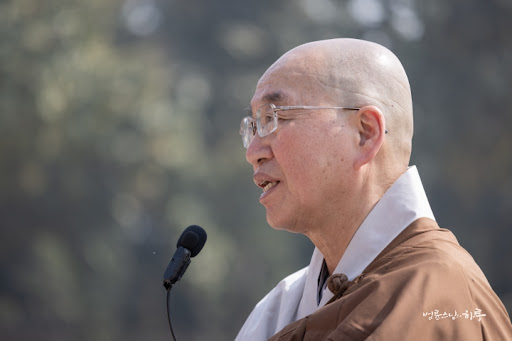
“Sarnath is the place where the Three Jewels of the Buddha, the Dharma, and the Sangha were established, and where lay practitioners appeared for the first time. The first upasaka, a male lay practitioner, was Yasa’s father, and the first upasikas, a female lay practitioners, were Yasa’s mother and wife. In this sense, Sarnath is very meaningful.
“The Buddha also ordained Yasa and 54 of his friends here. Four of Yasa’s friends from Varanasi came to look for Yasa, but after listening to the Buddha’s teachings, they took refuge in the Buddha. At the time, there were about 300 kingdoms in India, and 50 of Yasa’s friends from various kingdoms came looking for Yasa and the four friends, fearing that something bad might have happened to them. But after listening to the Buddha’s teaching, they also joined the Sangha. As a result, 55 people were ordained. This brought the number of enlightened beings to 61: the five bhikshus the Buddha first ordained, Yasa and his 54 friends, and the Buddha himself. It was at this stage that the Buddha urged his disciples to spread the Dharma.
‘I am free from all shackles, whether human or divine. You too are free from all shackles, whether human or divine. Go now and spread the Dharma.’
“Yasa’s father, mother, and wife were lay practitioners like you, so bear in mind the significance of the establishment here of the Threefold Refuge and the Five Precepts. The Threefold Refuge and the Five Precepts are not for ordained monks. These are for lay practitioners who practice while living as householders.
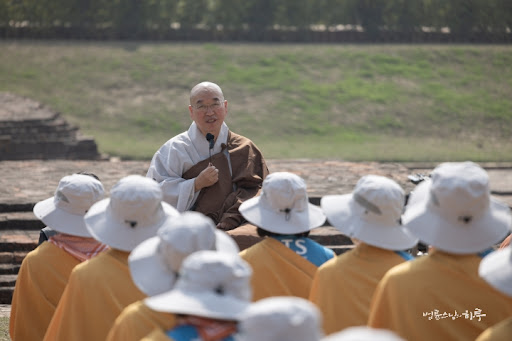
“Nirvana means being free from all suffering. It is a state of no afflictions; no sorrow, hatred, resentment, worry, anxiety, or anguish. But it is not a state of excitement. It was very difficult to explain this state to people who had never experienced it. It is the same today. Instead of pursuing or staying in a state without any suffering, you pursue enjoyment. As a result, you can’t escape from suffering.
Looking for people with ears to listen
“The Buddha looked for his companions to share the Dharma he had realized. He came all the way to Sarnath to share the Dharma. We might think that people would scramble to meet a fully enlightened one such as the Buddha, but contrary to our assumption, the Buddha came here looking for people with ears to listen.
“His friends, who had practiced with him for six years, were absorbed in asceticism. When you practice asceticism, you deny all bodily pleasures: first, not washing your body; second, not eating soft foods; third, not being choosy about where to sit or lie. After realizing that the path to awakening was the middle way, the Buddha took a bath in the river, ate milk-rice porridge, sat on grass obtained from a herder, and meditated under a tree. When the five ascetics saw the Buddha acting this way, they thought he had abandoned the practice.
“It’s not that he took a bath in warm scented water, he just bathed in the river; it’s not that he desired all kinds of food, he just ate porridge after a long fast and sat on an armful of ordinary grass obtained from a herder. But in the eyes of those ascetics, he appeared to be pursuing bodily pleasures.
The path to total freedom and happiness
“However, the Buddha perceived that neither the pursuit of bodily pleasures nor the mortification of the body is the path to enlightenment. Instead, he discovered the Middle Way, recognizing desires as they are.
“The important thing is not the food, clothing, or shelter, but exploring and investigating the cause of suffering and removing it. Only then can you attain liberation. But if we form and cling to a notion of liberation, we will suffer again even after attaining liberation. Therefore, we make a vow not to suffer again and to maintain the eight right perspectives in our daily lives. These eight right perspectives are the Noble Eightfold Path.
“Keep your mind and body at ease without becoming excited or tense; be aware of the workings of your mind and body and be unhindered by them; and restrain your speech, thoughts, and conduct in everyday life. Then, wisdom and right thought will arise in you. Only then can you be free from suffering. Even if you suffer because of momentary clinging, you can recognize it and escape from it right away. Even if anger, irritation, hatred, resentment, sorrow, worry, or anxiety arose, you can recognize right away that you’ve missed its arising and restore equanimity.
The first day that the path to liberation and happiness was laid out for the world
“After listening to the Buddha’s teachings on the Middle Way, the Four Noble Truths, and the Noble Eightfold Path, Kaundinya was instantly lifted out of the darkness. Realizing the profundity of the Dharma, Kaundinya rose and bowed to the Buddha. He showed respect to the Buddha as his teacher. It is said that the Buddha was happier when Kaundinya was awakened than when he was awakened, and he exclaimed: ‘Kaundinya has understood the Dharma!’ Because it proved that not only himself but also others could be enlightened.
“The other four ascetics were baffled as to why a friend bows to a friend, but the dialogue continued for three more days with questions and answers, and two more ascetics were enlightened. In another three days, two more ascetics were enlightened. Thus all five ascetics were enlightened in a week.
“Through this, the path to liberation, the path to freedom, the path to becoming one’s own master was laid out for the people of the world for the first time. Determinism—whether it is claimed that one’s life is determined by past lives, by god, or by the time of birth—was the dominant ideology at the time. This meant there was no escape from suffering. To escape from suffering, Hinduism claimed that one needed to make sacrifices to the gods. Some claimed that one needed to bathe in the Ganga. And yet others claimed that one needed to pray to the gods. But the Buddha taught that we can escape from suffering by identifying and removing the causes of suffering.
“This profound Dharma started here in Sarnath and began to reverberate around the world. The five ascetics had been practicing for a long time. But Yasa was a young man, a man in pursuit of pleasures—the five strands of sense pleasure—but he was enlightened after listening to the Buddha’s teaching once. It was because he realized that pleasure is suffering. Because of his enlightenment, his father, mother, and wife also took the path to liberation and nirvana as lay practitioners. The path to becoming a practitioner who understands the Dharma was laid out here in Sarnath for the first time.
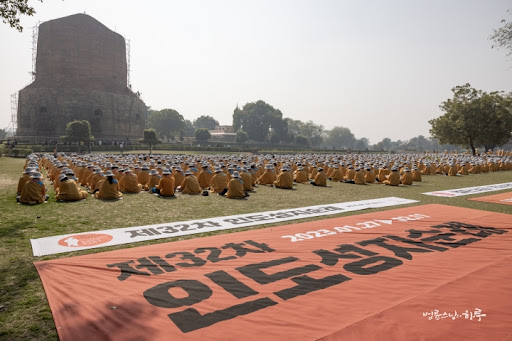
“This is the place where the Buddha set the Wheel of Dharma in motion and blew the horn of the Dharma. So, let’s make a vow here.
‘Let’s guide people to this Dharma so that they can live a life free of suffering as the masters of their own lives under any circumstances, without blaming others, or heaven, or their past lives, or time of birth, or the world.’
“Here in Sarnath, where the Buddha blew the horn of the Dharma, let’s vow to spread the Dharma around the world. Let’s take refuge in the Three Jewels and receive the Five Precepts, just as Yasa’s father and wife did, and, here today, let we 1,250 practitioners declare our vow to spread the Dharma far and wide, just as the Buddha and his 60 disciples did.
Go on the pilgrimage as 1,250 arhats
“For the next 15 days, let our mind not be swayed by circumstances, even if we shiver in the morning, sweat during the day, feel hungry, or feel sleepy for lack of sleep. I hope you undertake this pilgrimage as would 1,250 arhats at the time of the Buddha, by keeping your mind wide awake.
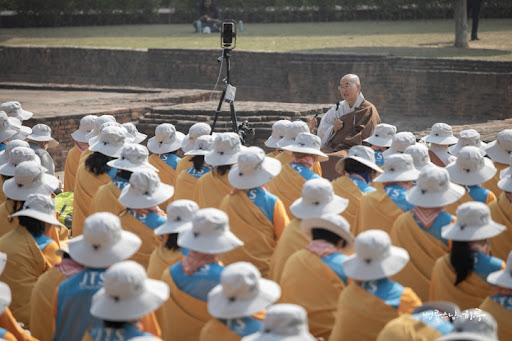
“If you maintain this perspective, this pilgrimage will be a practice and a joy. But if you cling to bodily comfort, you are likely to complain, regret your decision to be here or hate me, even if you said that you respected me before. I hope you and I manage our minds well so that we become good Dharma friends rather than enemies after coming all the way here.”
Jungto practitioners in Korea watched the Dharma meeting live-streamed on Youtube. Sunim asked the practitioners in Korea to have the same mindset as the pilgrims before completing his talk.
Next, all 1,250 pilgrims recited the vow to spread the Dharma, and the choir led the song ‘Aspirations of Bodhisattva Samantabhadra’, and everyone joined in. Lastly, Sunim prayed for the fulfillment of our vow.
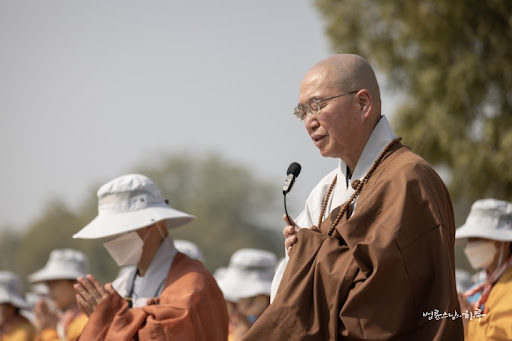
“Today, we 1,250 Jungto practitioners made a vow and pledged in front of Dhamekh Stupa in Deer Park, Sarnath, as we begin our pilgrimage retracing the footsteps of the Buddha.
“The Buddha awakened the five ascetics, Yasa, and his friends, his mother, his father, and his wife. In the same way, we will lead our families and acquaintances to this wonderful Dharma.
“Just as the Buddha urged the 60 arhats to spread the Dharma, we 1,250 practitioners vow to spread the Dharma around the world following the Buddha’s teachings.
“We vow to spread the Dharma to every corner of Korea, to the world, to any place where there is suffering.
“For the merit of making this vow, may all buddhas and bodhisattvas help us to eradicate all the karma we’ve accumulated, to continue our practice, and to spread the Dharma. And may heaven, and all holy beings protect us to fulfill our vow.“
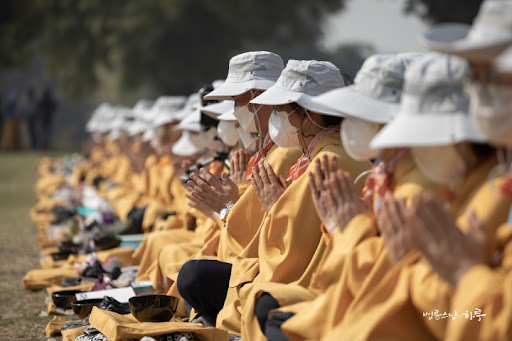
The 1,250 pilgrims in yellow robes, and with bowls in their hands, walked around the site, earnestly reciting the Threefold Refuge in Pali.

Buddham saranam gacchami
Dhammam saranam gacchami
Sangham saranam gacchami
The pilgrims walked past the front of Dhamekh Stupa, went around Dharmarajika Stupa, walked past the Ashoka pillar, walked around Mulagandhakuti Vihara, and returned to where they started. Sarnath was filled with waves of yellow robes.
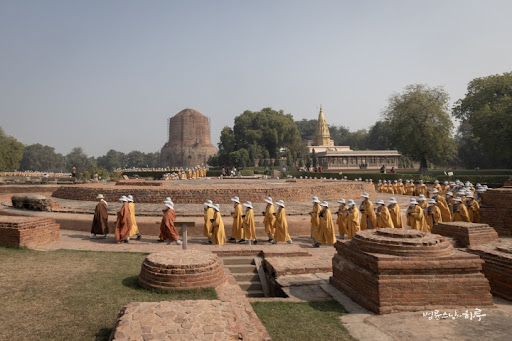
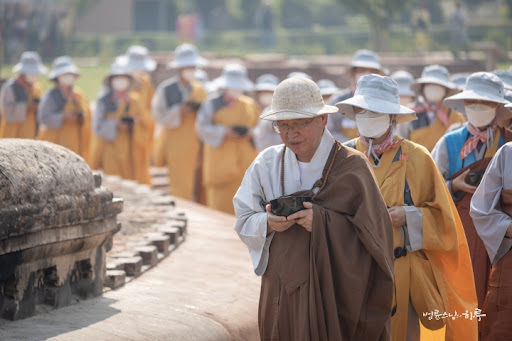
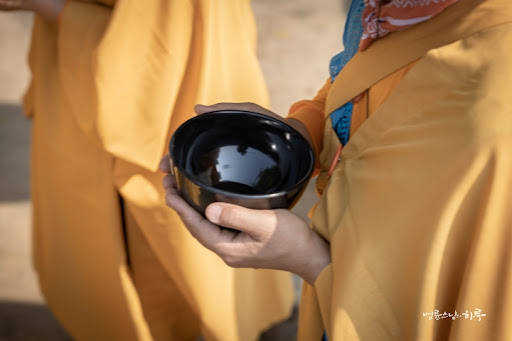
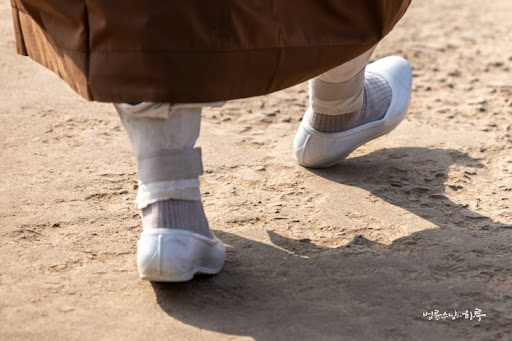
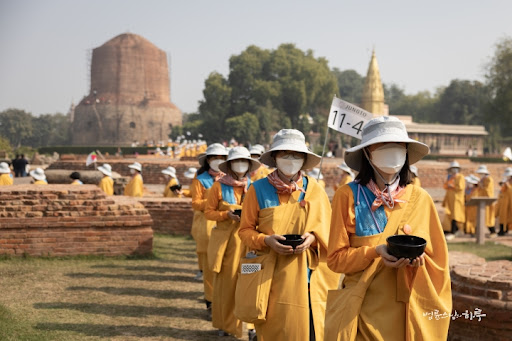
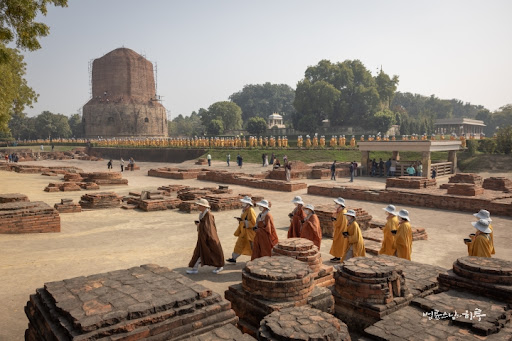
Lastly, a photo was taken of all 1,250 pilgrims.
“Let’s be like the Buddha!”
All 1,250 pilgrims were included in a photo.
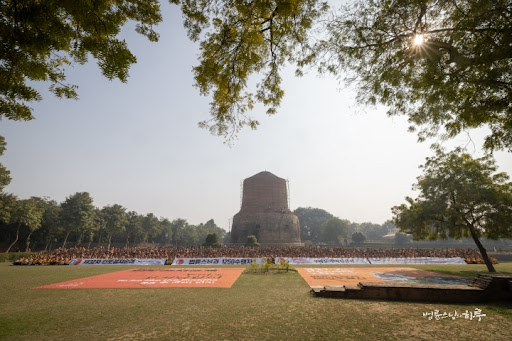
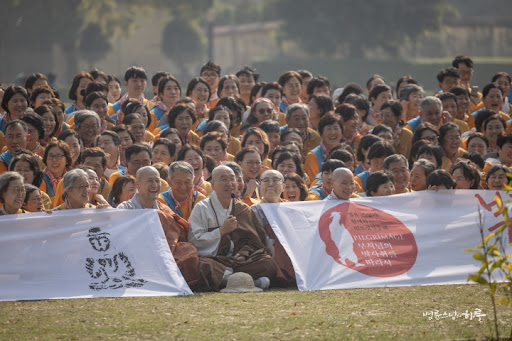
Sunim then took a photo with the Team B pilgrims grouped by their bus before leaving Sarnath.
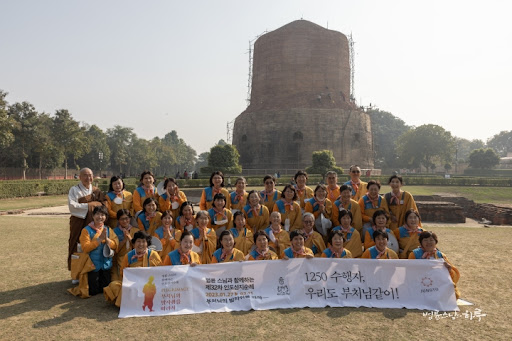
The program at Varanasi, the first pilgrimage site, concluded without incident. Sunim left Varanasi and headed to Sujata Academy.
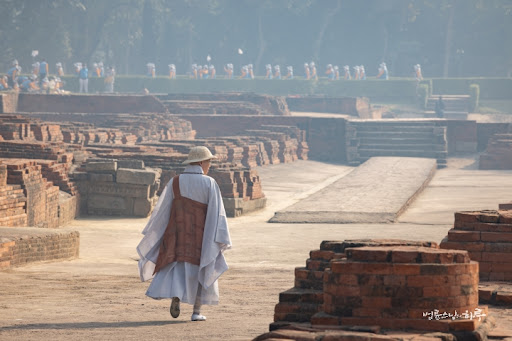
The buses transporting the Team A pilgrims left Varanasi at 3:30 pm, crossed the Ganga, and drove for seven-and-a-half hours, arriving at Sujata Academy at 11:00 pm.
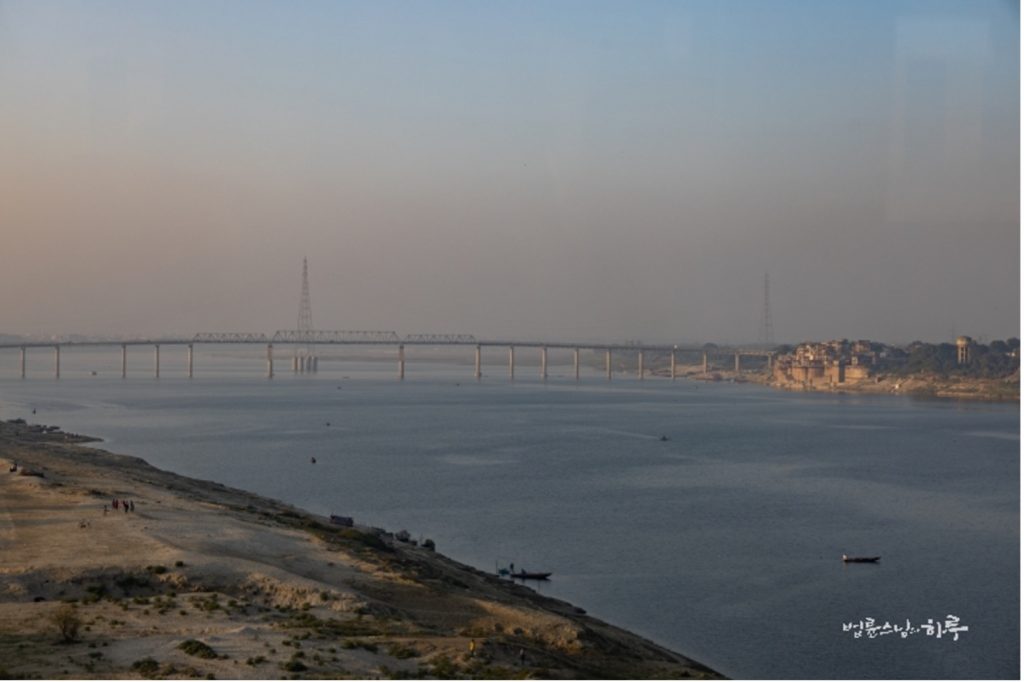
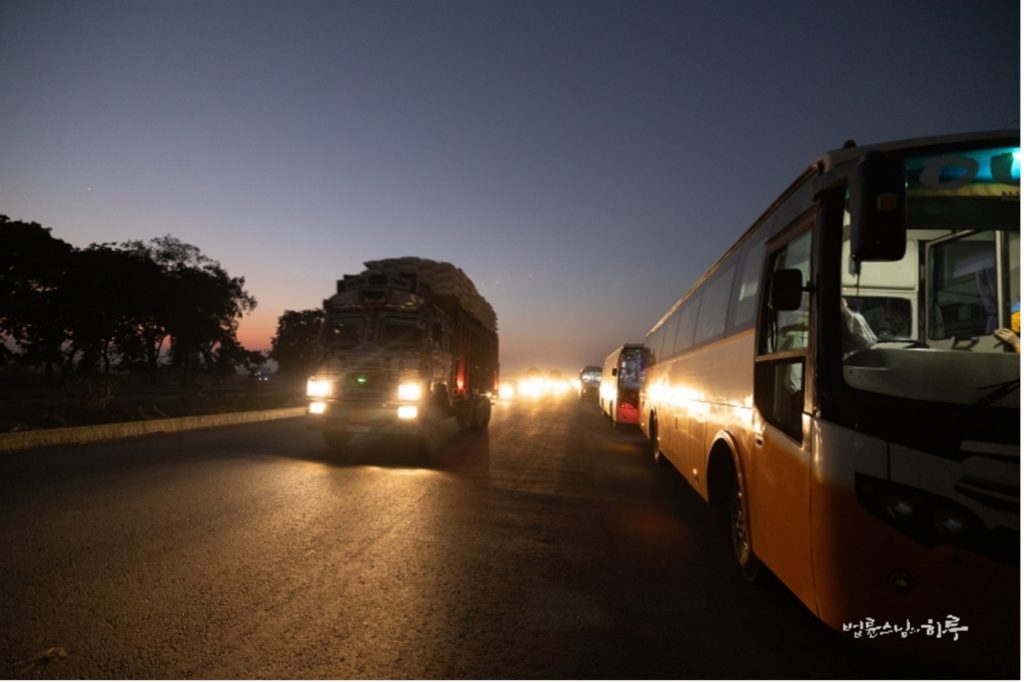
The staff of JTS India welcomed the pilgrims and helped them carry the boxes containing communal items. Sunim also changed into his work clothes and carried boxes before concluding the day’s schedule.
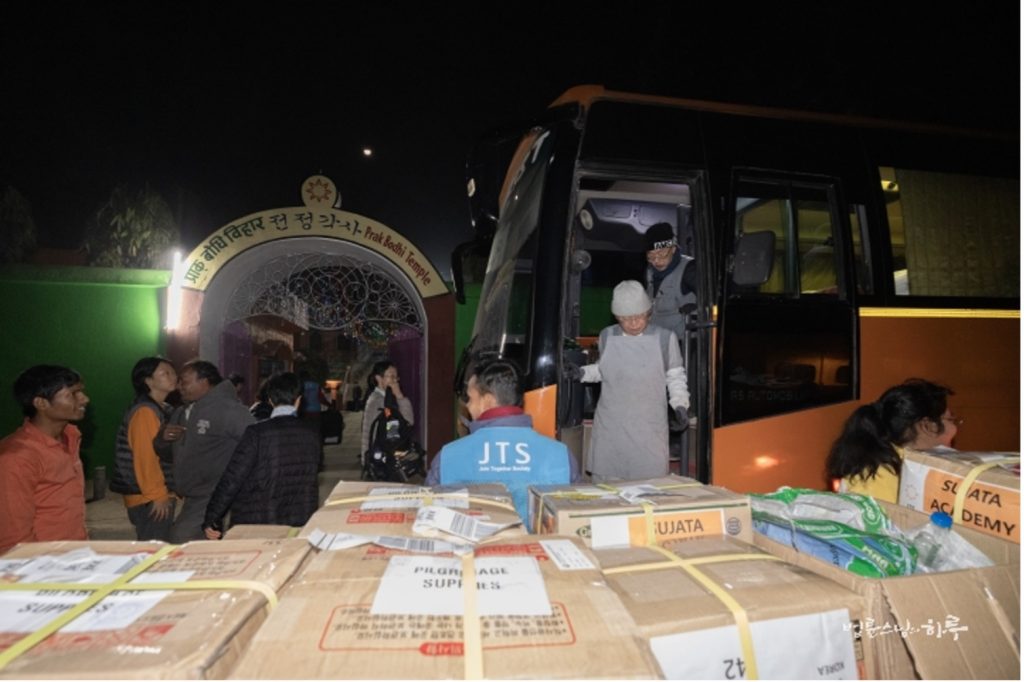
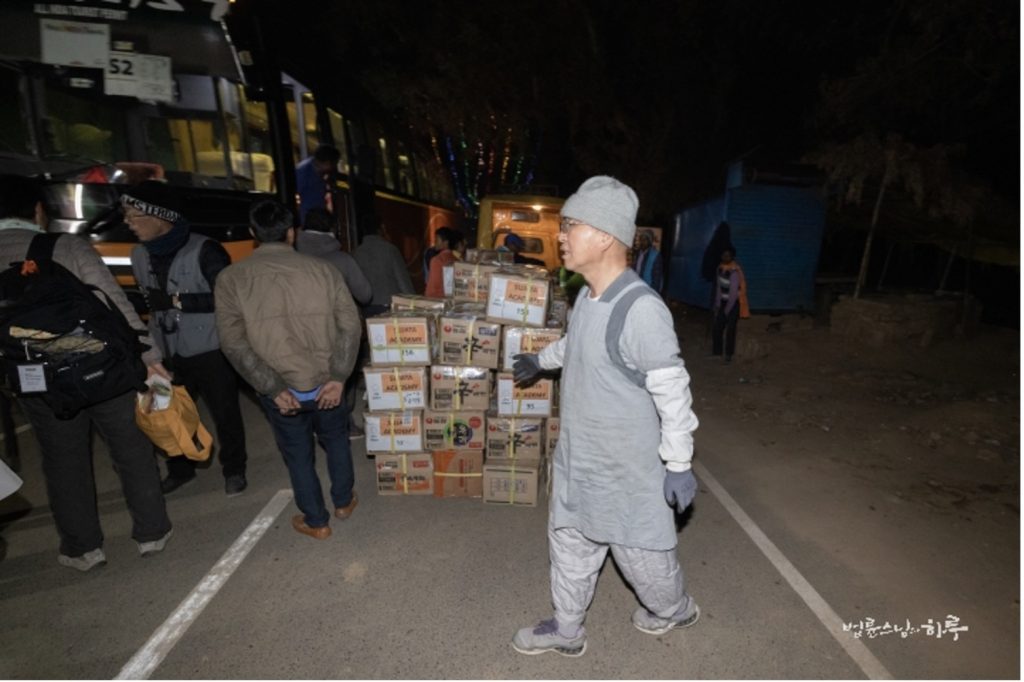
Early tomorrow morning, Sunim will go to Bodh Gaya for a Dharma meeting to be live-streamed for Dharma volunteers. In the afternoon, Sunim will participate in a welcome ceremony for the pilgrims at Sujata Academy, and make a pilgrimage to Pragbodhi Mountain and the Dungeshwari cave complex.
© 2024 Jungto Society - All Rights Reserved


